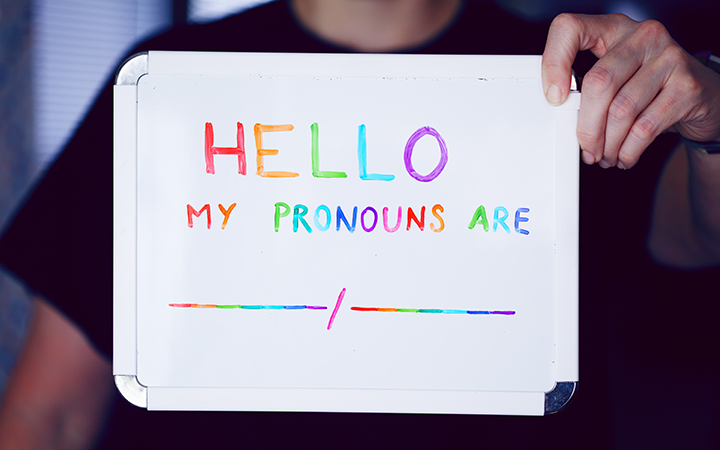Insight
He/She/They: Prioritising Preferred Pronouns

You’ve probably seen the following popping up on social media profiles or email signatures after people’s names: she/her, he/him, they/them, or even they/he or she/they. But what does it mean?
It’s actually not that complicated! Pronouns simply replace a proper noun, or name, in conversation. Instead of saying “That’s Trevor’s coat” you could say “That’s his/her/their coat.”
Pronouns have been deep within the ongoing conversation of gender and gender identity. Before we dive into how to correctly use personal pronouns, let’s define the differences between sex, sexual orientation, and gender.
Sex refers to a person’s biological status and is typically assigned at birth (male, female, intersex).
Gender is often defined as a social construct of norms, behaviors and roles that varies between societies and over time (man, woman, nonbinary).
Sexual orientation refers to physical, romantic and/or emotional attraction to members of the same and/or other genders (straight, gay, bisexual, lesbian, etc.)
See how they’re all different? It’s important to note that no matter what someone was assigned at birth (male/female/intersex), their gender identity exists separately. It’s gender identity that tends to influence pronouns.
Pronouns & Business Travel in Australia
Using correct pronouns is a sign of respect, and organisations are taking note. As of 2024, 64 countries still ban LGBTQ+ people, highlighting the importance of ensuring inclusive and safe travel for all.
Australia has made strides in LGBTQI+ rights though. In 2019, the Australian Passport Office recognised the use of 'X' for non-binary individuals and in 2018 same-sex couples can finally wed. But, with the above stat still a thing, Smartraveller Australia reminds people to check the entry requirements for travellers with non-binary identifiers and be mindful of marriage recognition in other countries.
If you need information on LGBTQI+ rights in different countries, the Australian Government's Smartraveller website can be helpful.

Gender Identity and Travel Technology
Once a traveller’s personal pronouns are known, it’s important to make sure their gender identity is affirmed throughout the travel process. While many Human Resources Information Technology (HRIT) systems now include pronoun options, travel tech is still catching up. International airlines like United Airlines and American Airlines both let travellers choose a non-binary gender identifier when booking trips. Although Australian airlines like Qantas, Jetstar and Virgin Australia do not yet allow non-binary gender markers when booking trips. The industry is slowly moving toward more inclusive practices, but for those organisations that are not, they are coping a lot of heat from the community to get on board.
While many companies in the corporate travel industry are working together to ensure technology supports travellers of all identities, the profile still needs to sync with other systems to really operate seamlessly. Not all Global Distribution System (GDS) and Online Book Tool (OBT) systems currently support X or U gender markers or non-gendered titles, which could cause a break in the connection between systems. Airlines, hotels, Travel Management Companies (TMCs) and other travel organisations all need to collaborate to address the barriers to a seamless travel experience for transgender and non-binary travellers.
The journey of affirming gender identity in travel still has a long way to go, but the first place we can start is with our tech and policies.
Next Steps
There are simple things you can do to start your organisation on the right path to gender equity and inclusion. Encourage employees to include personal pronouns in their email signatures, virtual meeting profiles, and nametags at in-person events. Switch to HRIT systems that support personal pronouns and pass out literature that helps employees and business travellers understand the importance of respecting personal pronouns and gender identity. Together, we’ll make the business travel world an even more inclusive place.
